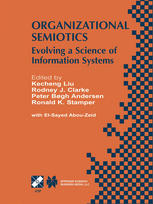

Most ebook files are in PDF format, so you can easily read them using various software such as Foxit Reader or directly on the Google Chrome browser.
Some ebook files are released by publishers in other formats such as .awz, .mobi, .epub, .fb2, etc. You may need to install specific software to read these formats on mobile/PC, such as Calibre.
Please read the tutorial at this link: https://ebookbell.com/faq
We offer FREE conversion to the popular formats you request; however, this may take some time. Therefore, right after payment, please email us, and we will try to provide the service as quickly as possible.
For some exceptional file formats or broken links (if any), please refrain from opening any disputes. Instead, email us first, and we will try to assist within a maximum of 6 hours.
EbookBell Team

4.1
40 reviewsOrganizational Semiotics: Evolving a Science of Information Systems covers such issues as:
-Fundamental concepts such as 'information', 'data', 'message', 'communication', 'knowledge', 'organization', 'system' and so on;
-Properties of signs vital to organizational functioning, such as their meanings, the intentions they express and the valuable social consequences they produce;
-'Architecture' of organizations when they are viewed as information systems, based on their semiotics features;
-Understanding language in organizational contexts, for example, the limitations on the language used to conduct business affairs;
-The empirical study of communications for requirements elicitation;
-Applying semiotic categories (e.g. physical, empiric, syntactic, semantic, pragmatic, social) to various problems;
-Organizational knowledge representation;
-Business process re-engineering methods and the design of e-commerce systems.